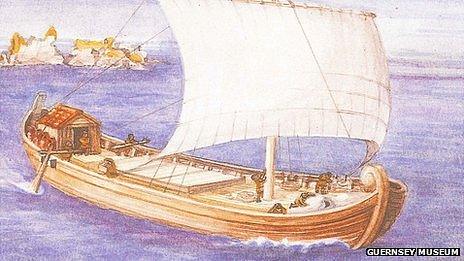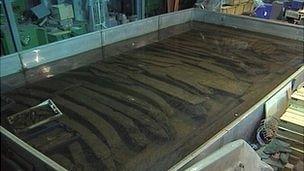Housing Asterix, Guernsey's Gallo-Roman wreck, to cost 'almost £1m'
- Published

Artefacts found on the ship show it traded in Algeria, Spain, France and England
Creating a permanent home for the Gallo-Roman wreck found off Guernsey would cost "the best part of £1m", says the island's museums director.
The Asterix, a 3rd Century trading vessel, was uncovered in St Peter Port harbour entrance in the 1980s.
A public-private partnership to house the vessel at Oatlands in St Sampson fell through earlier this year.
Dr Jason Monaghan said it was not just about homing for the ship, but creating a quality permanent exhibition.
He said there were currently no firm plans for the wreck to return to the island from Portsmouth where its timbers have been undergoing conservation work at the Mary Rose Trust.
Dr Monaghan said: "We got a long way down the path of discussing with the owners of Oatlands about the ship going on display there.
Conservation work
"They came up with a very good design for building where the ship could have gone but we never got as far as the fine detail of how it would all work and time has just moved on."

Dr Jason Monaghan said it was the largest of the three ships of this type found around the world
He said Guernsey deserved something similar, but smaller scale, to the £35m Mary Rose Museum in which the ship and thousands of the 19,000 artefacts found on board are displayed.
"We would need probably the best part of £1m to put the ship on show with other objects from Guernsey's maritime past, which would make it interesting enough to visit," he said.
"You could stick it in a building and put it on show for much less than that. But what the visiting public want is something that will bring the past to life, which is what they're doing with the Mary Rose."
'Most intact'
He said there was an attempt not long after it was raised to house it in Castle Cornet, but none of the rooms was big enough for the ship, which even in its wrecked state is more than 60ft (18m) long and 18-20ft (5-6m) wide.
Pottery found on board the ship showed it traded from Algeria, Spain, western France, England and up the English Channel before it wrecked.

The timbers have been undergoing restoration work at the Mary Rose Trust since 2006
Dr Monaghan said: "It is a Gallic-style ship built by the Celts, but it was equipped in the Roman fashion, so it had Roman roof tiles, a Roman bilge pump and it was operating at the height of the Roman Empire in the 3rd Century AD.
"It's the only Roman ship surviving in this state outside the Mediterranean and it's the largest sea going ship of its antiquity in western Europe.
"Only three ships of this type have been found. It's the largest, it's the most intact and it's the one that has survived in the best condition."
- Published2 January 2013
- Published29 September 2012
- Published14 March 2012
- Published26 July 2010
- Published15 July 2010